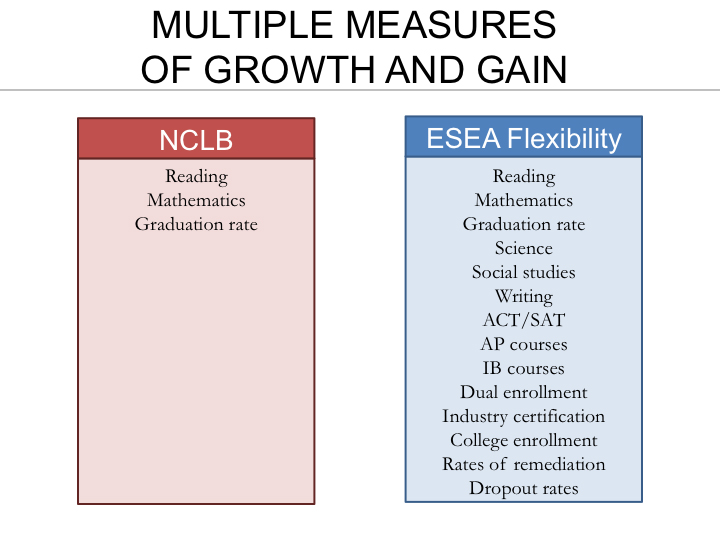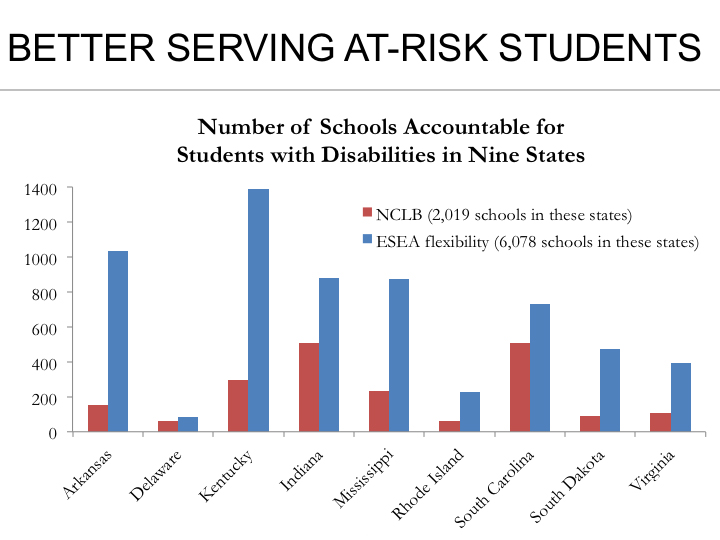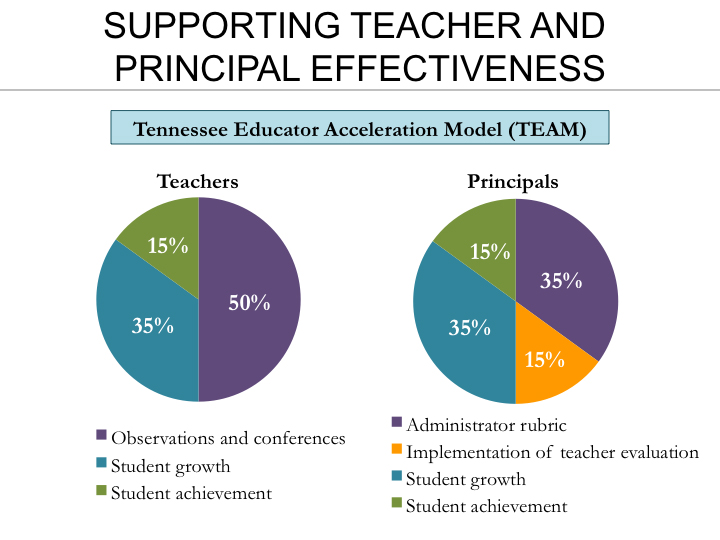
Secretary Arne Duncan testified on Capitol Hill Thursday during a hearing on ESEA flexibility. Official Department of Education photo by Leslie Williams.
States and their schools are breaking free from the restrictions of No Child Left Behind and pursuing new and better ways to prepare and protect all students, Education Secretary Arne Duncan told a Senate committee Thursday.
In a hearing before the Senate Health, Education, Labor and Pensions Committee, Duncan promoted the value of providing flexibility to states under the No Child Left Behind (NCLB) law, which the Department of Education began offering in 2011. Duncan said that granting states new flexibility through waivers was not his first choice—he would have preferred that Congress reauthorize, or amend the law instead. But in light of congressional gridlock over reauthorization, Duncan said that he was “not willing to stand by idly and do nothing while students and educators continue to suffer under NCLB.”
NCLB is the latest reauthorization of the Elementary and Secondary Education Act (ESEA). And Duncan said that NCLB has become a well-intended, but overly-prescriptive law that created incentives to lower standards, encouraged teaching to the test, mislabeled many schools as failures, and prescribed a one-size-fits-all accountability system that failed to support local solutions and innovation. With ESEA years overdue for congressional reauthorization, the Obama Administration sent Congress a Blueprint for Reform of ESEA in 2010.
Nearly two years later, after Congress failed to authorize ESEA, the Administration offered states the chance to pursue waivers to NCLB in September 2011. Duncan told the committee that “providing waivers was always, always our plan B.”
In his testimony, and during questions from the Committee, Duncan outlined in detail the ways in which the waiver approach, or “ESEA Flexibility,” – has strengthened accountability for at-risk students, improved evaluation and professional development for teachers and principals, and unleashed a wave of state-led innovation.
ESEA flexibility supports states and districts in replacing the “one-size-fits-all” interventions of NCLB and empowers states to tailor reforms that meet the needs of their students. Thirty-four states and the District of Columbia have been approved for ESEA flexibility, and nine states, plus Puerto Rico and the Bureau of Indian Education, have pending requests.
Duncan noted that states receiving NCLB flexibility “must demonstrate a commitment and capacity to improve educational outcomes for all students, close achievement gaps, increase equity, and improve the quality of instruction.”
Multiple Measures of Growth and Gain
One of the unintended effects of NCLB is that it provided incentives to lower academic standards—and 19 states actually lowered their standards after NCLB was enacted in 2001. The law’s narrow measures for school progress—annual reading and math test scores and high school graduation rates—also prompted teaching to the test and an overly simplistic model for assessing school progress. “Under No Child Left Behind there was far too much focus on a single test score,” Duncan said. “I’m more interested in outcomes,” Duncan added. “If you have the best third grade test score in the world but 50 percent of your students are dropping out of high school, you are not changing student’s lives. You can’t get a job with a third grade test score.”
Under ESEA flexibility, states are using multiple measures of growth and gain in student learning, rather than NCLB’s narrow measures. “This is a huge step in the right direction,” said Duncan. “All of the leadership, all of the creativity, is coming from the states.”
Better Serving At-Risk Students
At the hearing, Duncan said he was surprised to learn that under NCLB, low-income and minority students, English learners, and students with disabilities were “invisible” because schools were not held accountable for the performance of subgroups of students if there were not enough students in their subgroup to “count” under state rules. Duncan explained during his testimony that under flexibility, these students are no longer invisible, which “is a significant step in the right direction,” he said.
One example of how flexibility is helping at-risk students can be found in Arkansas. Under ESEA flexibility, Arkansas is now holding more than 1,000 schools accountable for subgroups that weren’t accountable under NCLB. Across all states receiving waivers to date, at least 9,000 additional schools are now accountable for subgroups for which they weren’t accountable before.
Duncan pointed out that states with waivers have set aggressive performance targets for all subgroups. They are using performance targets to tailor local interventions, rather than as a tool to label schools as failures. Waiver states are expecting progress for all subgroups–but much faster rates of progress for those that are furthest behind.
Recognizing and Rewarding Schools for Progress and Success
Under ESEA flexibility, states are recognizing a school’s student growth and success–and supporting interventions that work. Secretary Duncan cited the example of Columbus Park Preparatory Academy in Worcester, Mass. Under NCLB, the school was deemed to be among the bottom 20 percent of schools in the state, despite the fact that it was making significant progress in boosting achievement for traditionally low-performing students. “That school’s not a failure,” Duncan said. “That school’s a success … think of how demoralizing it is to teachers who are working so hard to be labeled a failure when you are seeing improvement each year.”
Supporting Teacher and Principal Effectiveness
“Talent matters tremendously in education,” Duncan said in talking about the new and far more robust evaluation systems that states are building under flexibility. States are developing evaluation systems that go far beyond NCLB’s minimum “highly qualified teacher” standards, and are using systems that measure and support effective teaching and leadership based on multiple measures, including student growth. “Great principals lead great schools. Great teachers do miraculous things with children,” he said.
Duncan described how Tennessee has been at the forefront of improving teacher and principal evaluation systems with the input from 17,000 teachers and administrators. The state also continues to receive feedback so it can refine and improve its evaluation system. “I have yet to meet a teacher who is scared of accountability,” Duncan said. They just want it to be fair. They want it to be honest.
Providing States with Flexibility to Move Forward With Reform
The federal role in education is relatively narrow, Duncan told the committee. “What’s exciting about ESEA flexibility, is that states are leading the way in strengthening education for all children,” he said. In explaining the federal role, Duncan said:
The federal government does not serve as a national school board … We don’t dictate curriculum, levy school assessments, or open and close schools. We don’t specify the content of academic standards or negotiate teachers’ contracts. We do have a responsibility to set a high bar to protect the interests of students, especially at-risk students. But how to reach that bar, I believe, should be left to the states.
Duncan concluded his testimony by noting that in a time of partisan rancor, ESEA waivers had an unusual bipartisan appeal in statehouses across the country. He observed that “we approach this work with both a tremendous sense of excitement, coupled with a real sense of humility.”
In the end, Duncan said, he didn’t have “a moment’s doubt” that state flexibility “is a major improvement for children and for adults over NCLB.” But he stressed the need to learn from any mistakes in the waiver process, correct them quickly, and share that learning across the country. “We can never let the perfect become the enemy of the good,” he cautioned.” And that is what we have done for far too long in education.” Ensuring a world-class education for every child, Duncan added, “is both a demanding challenge and an urgent imperative for our nation, our communities, and our children.”
Click here to read Secretary Duncan’s prepared testimony, and click here to watch a video of Secretary Duncan’s opening statement and the entire hearing.
Read the Department’s recently released publications highlighting ESEA flexibility.
Cameron Brenchley is director of digital strategy at the U.S. Department of Education










Despite what Jennifer Montgomery states, NCLB is not the driver of poor performance in the college classroom. There are many reason for this including 1) many good potential teachers no longer enter the profession because women have other options so students are deprived of their benefit, 2) schools that relied primarily on whole language did a disservice to those students who learn in alternative fashions, 3) education schools don’t focus enough on substantive skills and produce too many teachers that don’t write well, 4) teaching writing is a lot of work for teachers and there isn’t enough incentive in the workforce to assign and grade the kind of coursework necessary to produce good writing, 5) we live in an era where everyone is supposed to go to college and the average quality of the entrants has decreased as a result, etc.
The decentralized state of education is what has propelled innovation in our country for many years, and has proven itself to be superior to the more centralized counterparts found in most other developed countries. We have so many fine education programs in the universities around the U.S. training teachers to utilize intuition, creativity, and education psychology in order to formulate their judgement of the teaching methods and materials most relevant and significant to the individuals in their classroom. No system is perfect, however this freedom gives room for greatness. After all, isn’t freedom what we fight for in this country?
After many years now of teachers and students suffering under NCLB, regardless of whatever numbers and statistics you are using to measure its effectiveness (many of which are only measuring things that intrinsically support the act, and neglecting more comprehensive and realistic markers), you should be listening to the feedback from the people. Hear the people! Teachers in higher education are already seeing the results of NCLB in the level of abilities of the students now entering their classes, and frankly it is looking bleak. As a graduate assistant, I am shocked at the poor quality of work I have been grading recently, and shocked that these students could have graduated from high school without even the ability to formulate sentences. These students somehow made the grades needed to be accepted to a university.
The most amazing thing to me, is that there can be such a consensus among the general public about this issue and yet nothing has changed. What is going on up there?
~ Jennifer Meyer
It is imperative that we enable — not ensure, but at least not prevent — a world-class education for as many of our children as possible, and Congress can help this by repealing No Child Left Behind, which has too often come to mean “no child gets ahead” while “your child is getting left behind” foreign competition. Congress should reform ESEA so that it looks more like the UK’s Education Act 2011. This should mean upgrading academic accountability in America by introducing new qualifications for college admissions and scholarships that would resemble the International, European, and French baccalaureates. I have coined the term “American Baccalaureate Certificate” in relation to this proposal, and suggest that it can be tied to the Common Core standards, although these latter will need upgrading, particularly with respect to mathematics, if we are to meet the original National Governors Association mandate that the standards truly reflect best practices that will help our students succeed in the international competition they will inevitably face.
I can assure you in the state of Indiana nothing has changed as far as teaching to the test, and grading some schools as a failure. It is just as bad as it was under NCLB.
There are so many pitfalls regarding the State Assessment, I-Step, End of Course Assessment.
I work with our local NAACP, and we had to meet with former State Superintendant of Schools Tony Bennett last year because there were discrepancies in his application for the Waiver. Sincerely Oletha